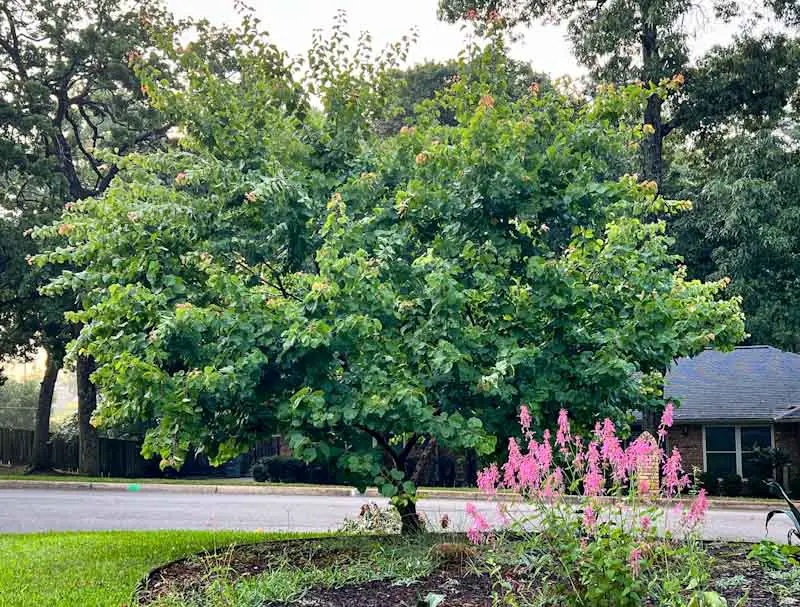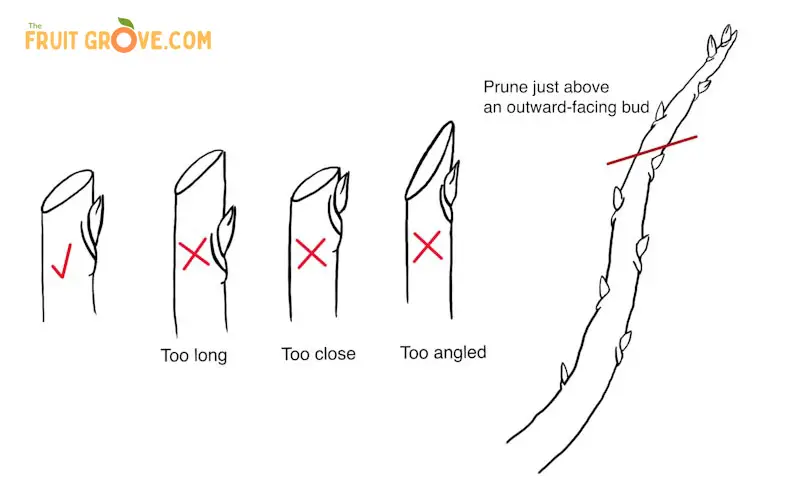
We may receive commissions from purchases made through links in this post, at no additional cost to you.
One of the things I love about gardening is the immediate gratification. Pull some weeds, the garden looks neater. Plant something new, and see an empty space filled. But some chores, like pruning fruit trees, are all about looking ahead. The work you do now in the “off” season will dramatically impact how the tree grows and fruits the following year.
The first time I pruned my apricot tree I was a little afraid that I would do it “wrong”. But, really, any pruning is so much more beneficial than neglecting to trim the tree year after year. At some point, I just had to take a deep breath and dive in. And the reward was my first crop of perfectly juicy, sweet apricots.
Pruning big, sprawling apricot trees can feel a little daunting, even after lots of practice. Thankfully, there is no one right way to do the job. It helps to know why you are doing it, what the benefits will be – and, of course, have some simple steps to follow.
The first thing to do is step back, assess the tree, and then make one snip at a time. In this article, we’ll go into why apricot trees need to be pruned, the best times to do it, and step-by-step instructions on how to go about it.
Apricot Tree Pruning Basics

Why do you need to prune apricot trees?
Pruning an apricot tree stimulates the tree to produce stronger growth and more fruit. Moderate, annual pruning helps to control the overall form of the tree, the amount of fruiting wood, and exposure to sunlight. It also increases airflow, preventing pest and disease problems.
It may seem counterintuitive, but pruning an apricot tree by about 1/3 will actually cause it to grow bigger than an unpruned tree. That’s because pruning reduces the size of the canopy the tree has to support, therefore giving the tree more energy to put toward new growth and fruiting.
Apricot trees can be very vigorous when they are young, growing about two feet per year. They will tolerate quite a bit of trimming, which can help you control the form and size of the tree. You can even keep the tree small enough to reach all of the fruit without a stepladder.
As the tree gets older, it grows less vigorously (maybe a foot per year, or less). An older tree may only need to be trimmed to get rid of damaged growth, crossing branches, or old fruiting wood that’s past its prime.
Learn more: The Life of an Apricot Tree: How Long Will It Bear Fruit?
Apricot Tree Fruiting Habits
Apricot trees fruit on wood that is two or more years old. The fruit buds form along last year’s growth and on spurs, or short twigs that grow off of the main branches. These spurs will produce apricots for three to five years.

If you prune away too much of the fruiting wood, the size of the apricot crop will suffer. But, it can be beneficial to remove some older fruiting spurs to encourage new ones to grow.
Related: Fruitless Apricot Tree? These 10 Things May Be to Blame
When to Prune an Apricot Tree
Apricot trees (and other stone fruits) should generally be pruned when they are dormant, in the late winter or very early spring. Summer pruning can be done to control vigor, increase sun exposure to ripening fruit, or remove damaged growth.
However, in climates with wet winter weather, it’s a good idea to do the main pruning at the end of summer. Apricot trees are very susceptible to moisture-loving fungal diseases, such as eutypa dieback, which occurs when fresh pruning wounds are exposed to excessive rainfall (particularly in the fall and winter).
If wet winter weather is the norm in your climate, prune after the fruit harvest, but at least 6 weeks before the heavy winter precipitation begins, to allow the pruning wounds to heal fully. Excessive exposure to moisture can invite rot or diseases, such as eutypa, into open tree wounds.

However, in many climates – especially those with hot, humid summer weather – it’s best to wait until the end of winter to prune apricot trees. Pruning while the tree is dormant will keep it from getting stressed and will stimulate the spring growth. Wait as late as possible, just before the tree starts to bloom in early spring.
Related: When Do Apricot Trees Flower? Best Varieties by Bloom Time
Even when the main pruning is done during dormancy, some summer trimming is beneficial. Always remove damaged or diseases branches whenever you see them, no matter the time of year. A branch that was damaged by high winds, for example, will invite pests and diseases to take hold in the ragged wood.
You can also prune lightly in the summer to curb excessive growth or thin out overly dense areas. Many apricot trees grow very fast when the spring weather is warm (I can attest to this – see my 5-year-old apricot tree in mid-spring, below!). I’ve found that some light spring trimming improves the apricots’ flavor and sweetness.

I live in a hot climate, zone 8b, so my ‘Golden Sweet’ apricot tree fruits in late May or early June. In the late spring, I thin out the leafy growth just a little so the ripening apricots are exposed to more sunlight. Thinning out the growth also increases airflow and keeps the tree healthier. Keep the summer trimming minimal if the weather is very hot, to avoid stressing the tree.
Learn about other hot-climate friendly apricots here: Tastiest Low-Chill Apricot Varieties to Grow at Home.
Pruning Cuts, Angles, and Tools
Different pruning cuts accomplish different things when trimming a fruit tree. Here’s a rundown of the different types of pruning cuts and the correct ways to utilize them.
Heading Cut
Heading cuts are used to remove the end of a branch and influence the growth of the tree. Cut a branch at an angle just above an outward-facing bud to encourage the buds just below the cut to grow into new lateral branches. This kind of cut strengthens branches and helps control the shape and size of the tree.

Thinning Cut
Thinning cuts are used to remove unwanted growth and to increase light and airflow. Remove a branch at its origin above the branch collar. This type of cut does not signal the tree to produce new growth.

Pruning Angles
Make heading cuts about 1/4-inch above a bud at a 45-degree angle. If you cut too close to the bud, the bud will die. If you cut too far above a bud, the would may take too long to heal over. The angled cut prevents moisture from sitting on the open wound, which could lead to disease.
When choosing which branches to keep and which to prune, prioritize branches with a wide crotch angle (where the branch meets the trunk), greater than 45 degrees. Narrower angles are weaker and can cause breakage if there is a heavy fruit load.
Three-Cut Method
When you need to prune a thick branch (more than about an inch), use the three-cut method to prevent splitting or tearing. This method prevents ragged wounds that can invite diseases, pests, or rot and cause major damage to the tree.

First, make one shallow cut under the branch, a few inches past where you want to make the final cut. Then, make a full cut on top of the branch just above or below the first cut. Once the bulk of the branch has been removed, you can then make a final cut to remove the stub of the branch.
Pruning Tools
These are the essentials to keep on hand for pruning fruit trees:
- Heavy-duty pruning shears (suggested: Felco 2 Hand Pruners)
- Pruning saw (suggested: Corona 10-inch Folding Pruning Saw)
- Loppers (suggested: Fiskars Bypass Loppers)
- Thick gloves (suggested: Something heavy-duty like these)
- Pole pruners/telescopic pruners (optional)
- Eye protection
- Long sleeves
- Stepladder (optional)
How to Prune an Apricot Tree – Step by Step

- Remove damaged, diseased, or dead branches. Start by removing anything that didn’t make it through the winter. Dead branches will be brittle and gray. Keeping dead or damaged branches on the tree is a surefire way to invite pests in, so they need to go.
- Thin out crossing or inward-growing branches. Look for branches that are growing too close together or are crossing each other. Choose one to keep and one to get rid of. Also remove branches growing into the middle of the canopy, since they will shade the interior of the tree and block light and air from circulating.
- Remove water shoots and root suckers. Water shoots are the vigorous branches growing straight up into the air. They are unlikely to produce fruit, and they can crowd the tree unnecessarily. Prune away low-growing suckers any time you see them.
- Shorten or remove branches to control tree height. Use a heading cut to remove about 1/3 of the length of branches that are too long. Make the cut just above an outward-facing bud to encourage the new growth to spread outward. Remove or shorten branches that are growing too high to control the overall size of the tree. If you prune consistently, you can keep the fruit within reaching height.
- Step back and assess. Take a look at the tree – are you happy with the overall form and balance? Do any areas look too dense or crowded? Aim to remove 1/3 (even up to 1/2) of the tree every year. Pay attention to how the tree grows this year so you know where to prune next year. You always want to balance removing some older growth without getting rid of too much fruiting wood.

Pruning a Neglected Apricot Tree
The steps are basically the same for apricot trees that have been left unpruned. The difference is that the trimming will need to be done over the course of several years. Prune gradually to begin influencing the growth of the tree – you don’t want to remove all the fruiting wood at once or shock the tree (which can kill it).
Prioritize removing the oldest growth first. Fruiting spurs older than about 5 years won’t produce apricots, anyway. Reduce the tree’s canopy by no more than 1/3 at a time. Pruning too heavily will either shock the tree or will cause it to vigorously produce leaves but no fruit.
Thinning Fruit on Apricot Trees
Apricots are notorious for not bearing fruit every year. One of the reasons for this could be that it produced too heavy a crop one year, which leaves the tree depleted of the resources it needs to fruit the next year (also called alternate bearing).

A way to combat this is by thinning out the young fruits before they mature. The tree will naturally thin some fruit – if you see baby apricots falling to the ground, don’t worry. But you can also manually thin the apricots when they are small (about the size of a dime) to reduce the fruit load.
Thinning has other benefits as well – the remaining apricots will grow larger and sweeter since the tree won’t be supporting quite so much fruit.
To thin apricots, simply pinch off the young fruits with your fingers. Remove any small fruits that are damaged or underdeveloped first. Aim to have the remaining fruits spread 4 to 6 inches apart along the branches.
It may hurt a little to remove fruit from the tree. After all, growing fruit is the whole point! And it isn’t always necessary to thin the fruit. But if the crop seems extremely heavy, thinning the apricots will increase the chances of having a more consistent harvest every year.

